In my previous post on Soviet Nostalgia and Varenichnaya №1, one of the dishes I tried was forshmak, a sort of herring pâté that was common in the USSR. It’s not just another popular Soviet food, though: in a country where around 1% of the population was Jewish around 1960, this is the only Jewish dish to have been assimilated into Soviet cuisine.
Yet forshmak predates the USSR. According to William Pokhlyobkin, it originates from East Prussia (today part of Poland, Lithuania, and the Russian exclave of Kaliningrad), where it was called vorschmack (which roughly means “appetizer”) and consisted of fried herring. I didn’t find recipes for the original dish in my meager East-Prussian cookbook collection, but it does appear in Elena Molokhovets’ seminal A Gift to Young Housewives, albeit quite transformed. The Russian appetizer, here called forshmak, is a baked casserole made of chopped cooked meat, herring, onion, eggs, and bread or potatoes (a later addition), with more or less cream to achieve different consistencies.
Fast-forward half a century, and this is still how it appears in the 1952 edition of The Book of Tasty and Healthy Food, with potatoes and some gratinéed cheese on top for a more Soviet touch. At some point, though, people stopped mixing fish and meat. Because, have you ever tried to find both on the same day in a Soviet store? They also started serving the dish cold, boiling the eggs first and keeping everything else uncooked. The casserole had turned into a pâté, and this became the preferred recipe – the only one I’ve ever been served. Today, this cold version is found in many Russian restaurants, either served in cute glass terrine jars or re-imagined as a modern plated appetizer. If Varenichnaya №1 provides an example of the former, then SAVVA, the main restaurant at Moscow’s Metropol Hotel, offers an instance of an elaborate plating that’s as pretty to look at as it is impractical to eat.
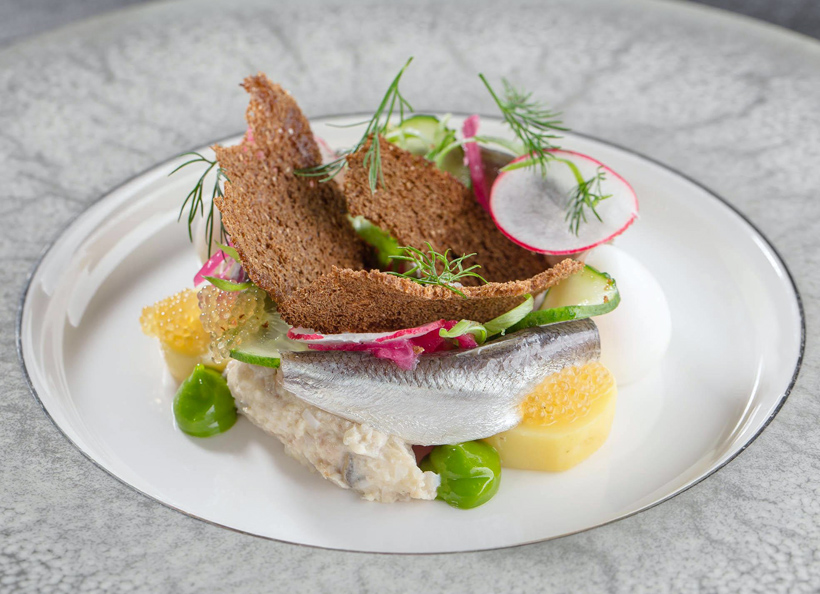
It’s unclear whether forshmak started as a Jewish specialty, or was adopted by Jewish food culture later on. Some, like Pokhlyobkin, claim that only the cold pâté version is Jewish. Regardless, considering the Soviet Union’s recurring anti-semitism, it’s rather surprising to find a Jewish dish among the staples of Soviet cookery at all. Then, come to think of it, the 1944 deportation of Crimean Tatars didn’t prevent the popularity of chebureki either. Should the assimilation of specialty dishes from repressed populations be seen as the oppressor’s culinary trophy? Maybe… Just look at the popularity of Crimean food and wine in today’s Russia!
Though a staple of both Russian and Jewish cuisines, herring often gets a bad rap. This very oily fish with a strong taste isn’t to everyone’s liking. It’s often considered poor man’s food, to the point that there’s a Yiddish witticism saying “Where there is no worthy man, even a herring is a fish”. Even with potatoes mixed in, the flavor of forshmak can still be too much for some.
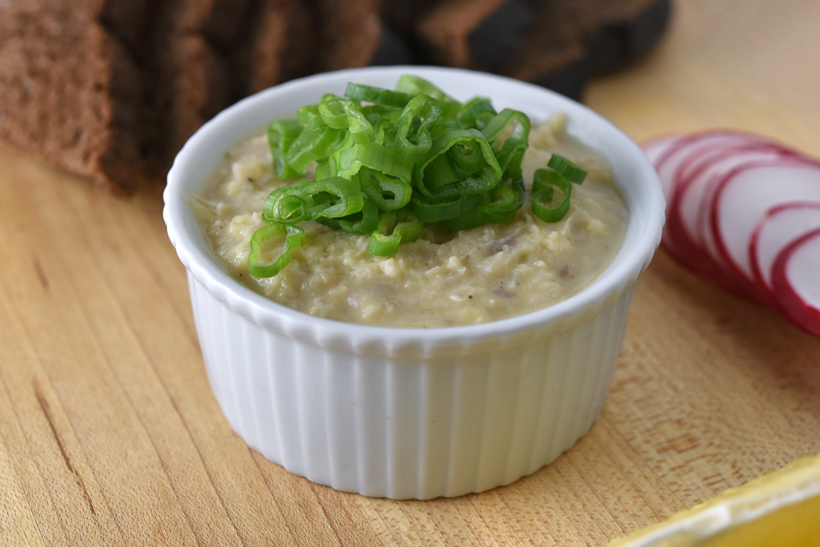
Given all of that, I wanted to create a tasty, approachable version of the dish. Two versions, in fact! One echoes the hot appetizer that it once was, and the other is a cold terrine to eat on bread.
I must say that reading the recipes for the forshmak casserole, I don’t think it’s gonna make a comeback any time soon. A baked dish of ground meat and fish mixed together with copious amounts of cream and whipped egg whites, it reads like a bizarre soufflé. Instead, I’m keeping roughly the same ingredients, but changing the proportions to make a kind of fishcake – in the spirit of Soviet cuisine, let’s call it a cutlet. Surprisingly, the veal-herring combo works quite well! Lesley Chamberlain’s The Food and Cooking of Russia suggests serving hot forshmak with the kind of tomato sauce often found with golubtsy, and this inspired me to make a tomato cream, with a mild and slightly tangy taste.

The cold forshmak proved more of a challenge. I started with cookbook recipes, but found that the results were often too sweet (due to the use of grated apple and sometimes sugar) and didn’t really have the texture of a pâté or a terrine (due to the use of large proportions of bread or potatoes). To me, a starchy gooey mass, even served in a cute jar, does not hold much appeal. But put too much herring, and the taste is far too strong. Luckily, there are plenty of other things with which one can combine herring, such as butter (which helps create a texture similar to my salmon rillettes) and smoked whitefish, which has a meaty texture and little taste of its own, thereby making it a good vehicle for smokey flavor. While the result is perfectly good on its own, simply spread on pumpernickel rye bread, I’ve also created a plated appetizer inspired by SAVVA’s version (I kept the cucumber and radishes), perhaps not as pretty but much better structured in terms of consumability.
The whitefish also makes sense by association, as the preferred herring for Jewish forshmak is schmaltz herring, which can be purchased at your favorite appetizing store, together with assorted smoked fish. I’ve been getting mine from Barney Greengrass.
Finally, I’m using herring roe for decoration and just a hint of flavor on both the cutlets and the terrine. Herring roe is often colored black to resemble sturgeon caviar, but it’s much blander – and much more affordable! Since it’s not all that exciting from a gastronomical perspective, it’s not very widespread. You can find some at Marky’s.
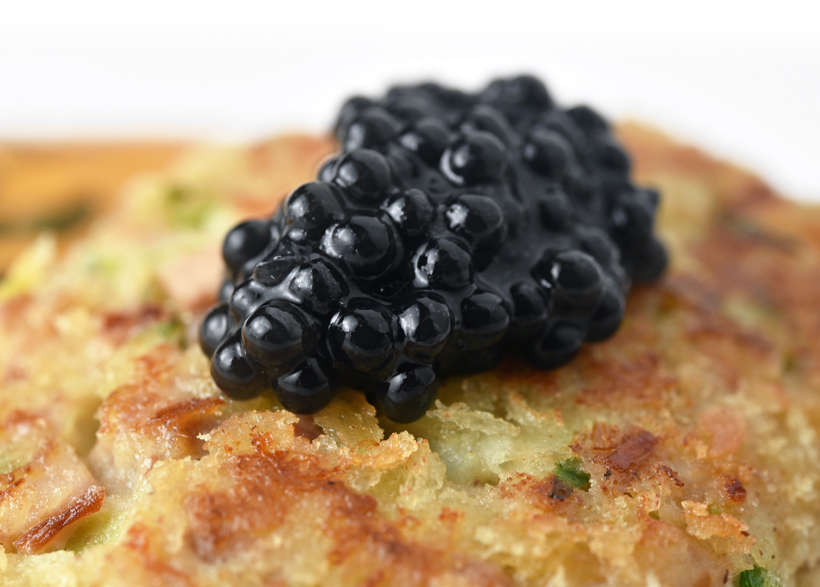
Forshmak Cutlets in Tomato Cream
The cooked veal, forshmak cutlets, and tomato cream can all be prepared ahead of time.
Cooked veal
Yields about 4 servings
300 g boneless veal breast (or boneless shank, or stew meat)
salt
canola oil
- Season the veal with salt, then sauté in canola oil in a hot pan over high heat, until brown on all sides.
- Transfer the meat to a sous-vide pouch, vacuum-seal, and cook in a 85 C / 185 F water bath for 6 hours.
- Take the pouch out of the water bath, and let cool for 30 minutes. Take the meat out of the pouch, and reserve the cooking liquid. Remove and discard any large chunks of fat from the meat, and reserve.
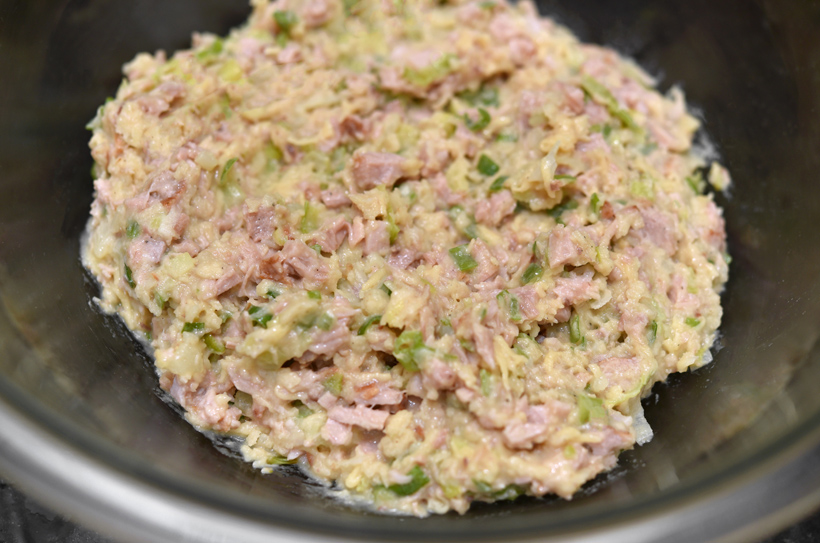
Forshmak cutlets
Yields 4 servings
45 g scallion whites, brunoise
10 g butter
90 g peeled Yukon Gold potato
20 g sour cream
60 g schmaltz herring
150 g cooked veal
50 g (about 1 large) egg, beaten
30 g grated Gouda cheese
15 g panko
10 g scallion greens, finely chopped
black pepper, ground
salt
- Sauté the scallion whites in butter in a small saucepan over medium heat until soft. Transfer to a large bowl.
- In a small saucepan, cook the potato in boiling water until very tender, about 20 minutes. Drain and transfer to the same bowl. Add the sour cream, and mash with a fork.
- Fill another small saucepan with water, and bring to a boil. Remove from the heat, then poach the herring for 30 seconds. Drain on paper towels.
- Chop the herring and the veal into a brunoise, then add to the same bowl, together with the beaten egg, grated cheese, panko, scallion greens, and black pepper. Mix well with a spatula, and rectify the salt seasoning if needed.
- Divide the mixture into four chunks of about 100 g each, and shape into flat oval patties, about 6 cm x 8 cm and 2 cm thick. Cover with plastic film, and refrigerate for at least 2 hours.
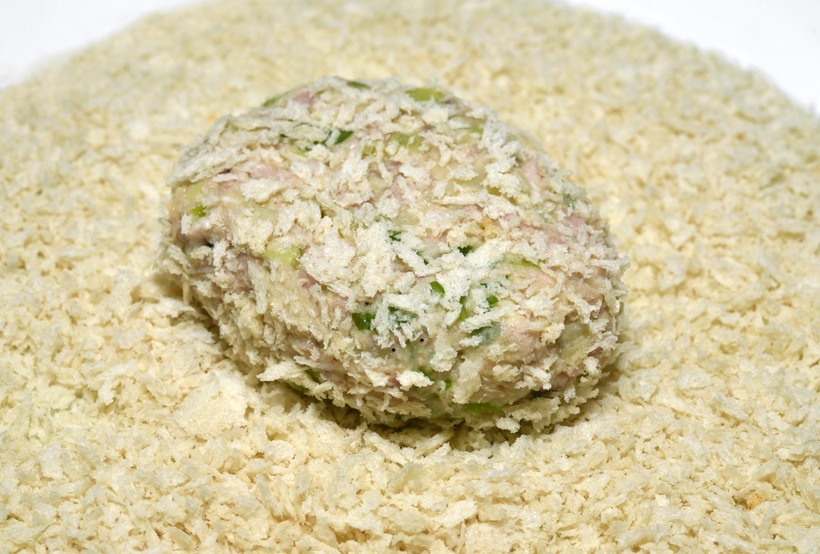
Tomato cream
Yields about 4 servings
75 g peeled onion, small dice
50 g peeled carrot, small dice
20 g light olive oil
12 g tomato purée
200 g canned whole peeled tomatoes, drained and seeded
salt
black pepper, ground
veal cooking liquid (about 50 g)
125 g heavy cream
115 g sour cream
- In a saucepan over medium heat, sauté the onion and carrot in olive oil until golden brown, stirring regularly.
- Mix in the tomato purée, and cook for a couple minutes, until the purée starts to brown.
- Coarsely chop the tomatoes, and add to the saucepan. Season with salt and pepper, then add the veal cooking liquid and heavy cream. Simmer over medium-low heat for 15 minutes, stirring occasionally.
- Transfer to a blender, and process until smooth. Transfer to a bowl, and stir in the sour cream, rectifying the seasoning if needed. Reserve.
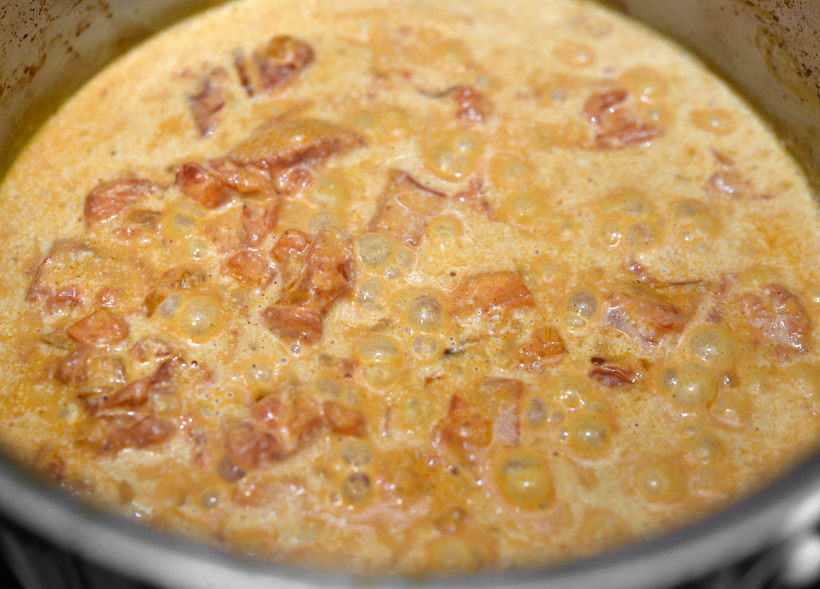
Assembly
Yields 4 servings
40 g panko
forshmak cutlets
15 g butter
10 g canola oil
tomato cream
40 g herring roe
20 g capers, rinsed
- Spread the panko on a plate. Bread the cutlets by rolling them in the panko, and reshape into pretty ovals.
- Heat the butter and oil in a non-stick pan over medium-low heat. Fry the cutlets on both sides until just golden.
- Transfer to an oven-proof dish, and bake in a 200 C / 400 F oven for about 10 minutes, until the cutlets reach an internal temperature of 60 C / 140 F.
- Reheat the tomato cream in a small saucepan over low heat (or in the microwave).
- Coat the bottom of each plate with a layer of tomato cream, then place a cutlet in the center. Top with some herring roe, and sprinkle some capers around the plate. Serve!
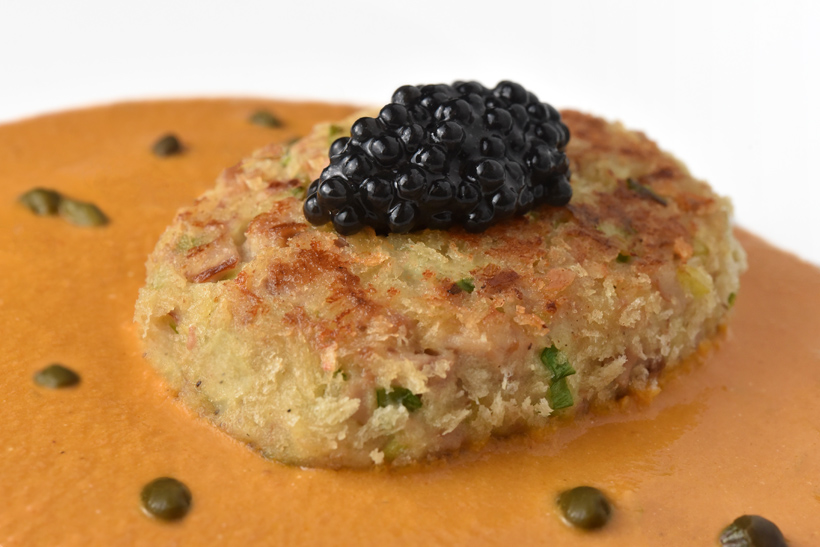
Forshmak Terrine with Cucumber, Radish, and Scallions
The forshmak terrine can be prepared the day before. The cucumber gel and the pickled radish, however, should be made shortly before serving. Gellan gum F for the gel can be purchased here.
Forshmak terrine
Yields about 4 servings (2 small ramekins)
65 g schmaltz herring
65 g smoked whitefish (skin and bones removed)
40 g peeled green apple, brunoise
25 g peeled shallots, brunoise
60 g butter
20 g egg yolks
7 g lemon juice
black pepper, ground
- Bring a small saucepan of water to a boil. Remove from the heat, and poach the herring for 30 seconds. Drain on paper towels, then chop into a brunoise. Reserve.
- Crush the whitefish with a fork to break into flakes. Reserve.
- In a small saucepan over medium heat, sauté the apple and shallots in half of the butter until soft. Add the remaining butter, stir until completely melted, then transfer to a bowl. Add the egg yolks, and mix with a fork for about 30 seconds.
- Add the herring, whitefish, lemon juice, and black pepper to the bowl, and mix with a fork. Cover with plastic wrap, and refrigerate for at least 4 hours.
- If you’d like to eat the terrine on its own, use two 100 ml / 4 fl. oz ramekins instead of the bowl, pressing the mixture down with a teaspoon to avoid air pockets. Serve with toasted pumpernickel rye bread, sliced scallion greens, sliced radish, and a lemon wedge.
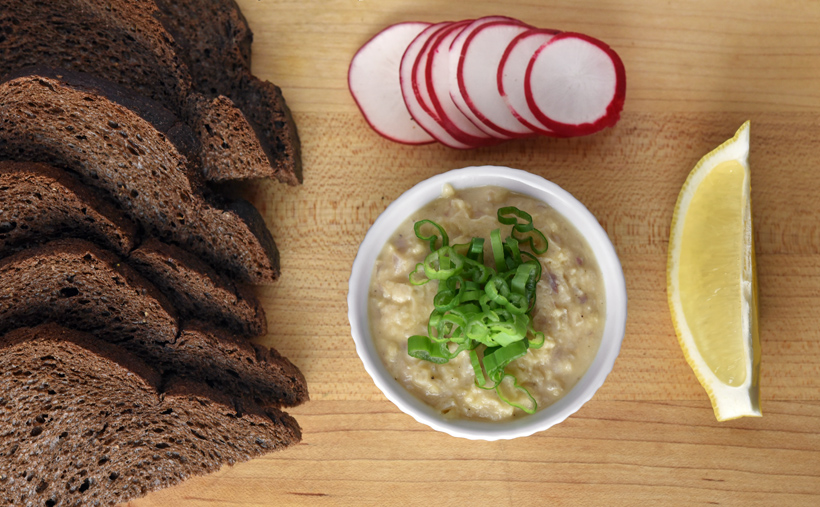
Cucumber gel
Yields over 4 servings
150 g cucumber (especially the peel, to obtain a greener result)
15 g white wine vinegar
4 g sugar
1 g salt
1 g gellan gum F
- Juice the cucumber, and strain through a chinois. Measure 110 g of juice, and discard the rest. If you don’t have enough, juice more cucumber!
- Place the vinegar and sugar in a plastic container, microwave for about 15 seconds to dissolve, then let cool.
- In a saucepan over medium heat, bring the cucumber juice with the salt to 194 F.
- Transfer the cucumber juice to a blender, add the gellan gum, and blend for 1 minute on high speed. Transfer to a bowl, and let cool over iced water until the mixture reaches room temperature and is completely set into a gel.
- Return the gel to the blender, add the vinegar mixture, and blend on medium speed for 2 minutes, pausing a couple times to scrape down the sides of the blender with a spatula.
- Pass the gel through a chinois, pour into a small squeeze bottle, and refrigerate for at least 1 hour. The color of the gel changes quickly; use it the same day for best results.
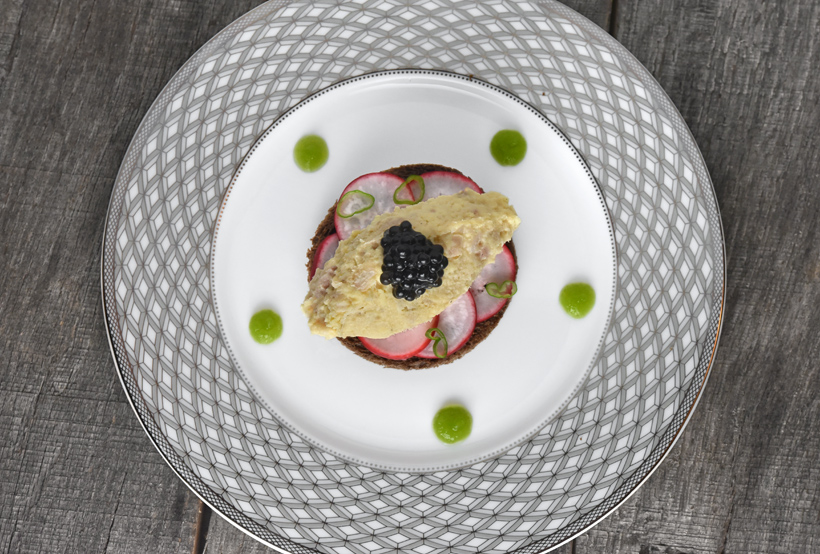
Pickled radishes
Yields 4 servings
40 g red radishes
15 g white wine vinegar
salt
- Thinly slice the radishes using a mandoline.
- In a bowl, toss the radishes in the vinegar, season with salt, and let rest at least 15 minutes.
Assembly
Yields 4 servings
4 slices pumpernickel rye bread
pickled radishes
forshmak terrine
herring roe
scallion greens, thinly sliced
cucumber gel
- Use a cookie cutter or ring mold to cut 7.5 cm discs out of the bread slices, and discard the trimmings. Toast the bread discs in a 200 C / 400 F oven until crisp.
- On each plate, place a toast in the center, and cover with slices of pickled radish. Scoop some forshmak terrine, using two tablespoons to shape into a quenelle, and place on top of the bread. Top with some herring roe, and sprinkle with scallion greens. Decorate the plate with a few dots of cucumber gel, and serve.


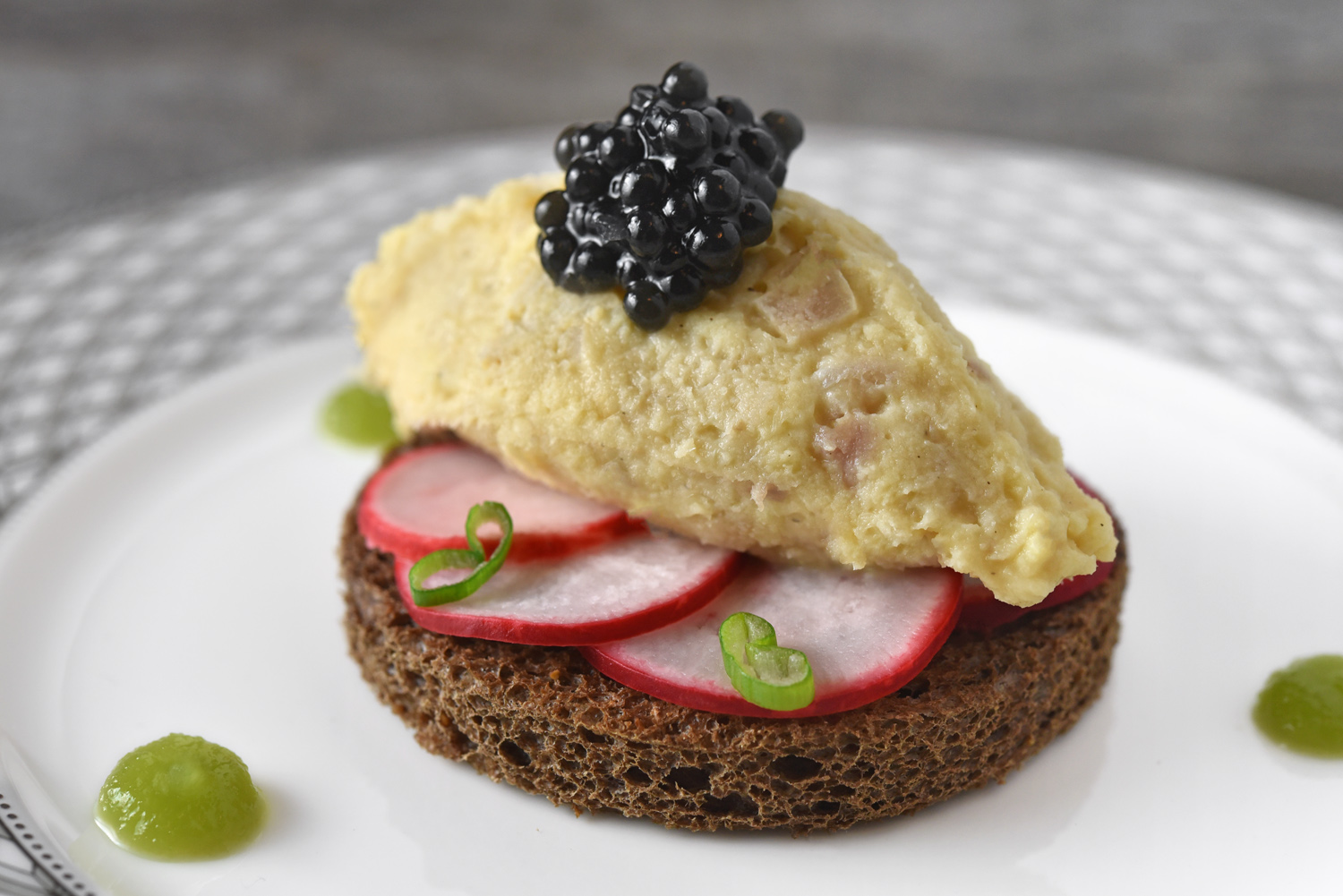
4 comments
Chopped herring and herring in cream sauce were two childhood favorites. It wasn’t until later in life that I realized I was an odd little kid. Also loved sardines.
Have you had fresh raw herring at Grand Central Oyster bar? They come in fresh in June usually. Served raw with chopped onions, chives and hard boiled egg. Delicious and a lot more mild in its fishiness
Another thing to try is herring roe sushi. The Japanese keep the roe in its sac and cure it in kombu. Deliciously crunchy, sweet and salty. Also a beautiful bright yellow. Usually topped with some bonito flakes for some smokiness
Thanks for all this delectability. Re the Jewish population of the USSR in 1960 tho,: it should be 1%, not 10%. Total population was about 210 million, and there were plus or minus 2 million Jews (not all of whom were Ashkenazic, tho most were). As in the US and elsewhere, Jews comprised a somewhat larger percentage of major cities like Leningrad, Moscow, Odessa, etc, but 10% of the country we weren’t. The herring was good tho.
Thanks for the correction, I’ll update the post now!
I think it’s pretty likely that the forshmak was a Polish dish first and then was adopted by Jewish cooks, because this original hot appetizer recipe version you offer mixes dairy and meat. Jewish cuisine is usually at least kosher-style, if not kosher, and mixing meat and dairy isn’t kosher, so that version is probably not Jewish.
The cold version is more likely to be Jewish because one may only prepare cold food on Shabbat (our sabbath). This might have been eaten as a “nosh” on Shabbat, or to serve at the late lunch / early dinner meal, “Seudah Slishit.”
Hope that helps! 🙂